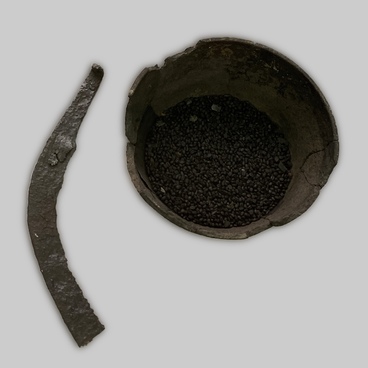In XVII–XVIII cent. there existed three types of shoe calks. The first and earliest type that was popular until mid. XVII century was the cut-in shoe calk. In the earlier half XVII century there appeared composite calks. The third type are the tapped calks, including those extending into the sole. It existed between the half of XVII, and XVIII century.
Among the archaeological discoveries in various Siberian cities, half-moon-shaped tapped calks of later times prevail. They were suited for both broad and narrow heels and had a universal application. Tapped calks had no nails, so they were easier to manufacture.
Shoemaking industry was a robust business in Kuznetsk. Most common footwear were high boots dyed with mineral pigments. Both men and women wore high red boots, most popular in those times. Such boots were frequently encountered in the Russian fairy-tales and illustrations to those.
Customs books hold the records of the batches of red leather of different quality that were sold in various Siberian cities. The heels and soles were made from several layers of leather glued together. The heels were of various shape and height: low and wide, or narrow and high. Initially, the toecaps were pointed and cocked, later they became wide and straight.
High boots of the service class people in XVII century had long bootlegs, high heels and pointed cocked toes. They were made of leather and dyed in different colors. The boots of rank and file Cossacks were made of coarse leather. High boots of ‘desyAtniks’ and ‘sOtniks: (command military ranks among the Cossacks) were not stylish but were made of “yuft” (Russian calf leather) – a finer and more expensive leather.
According to historical sources of XVII century, the calks were called “boot calks”, or “calks for boots”, “boot calks with nail”. They were attached to the heel and sole with sparrow bills. To fabricate the calks, bloomery iron and low-carbon steel were used. That quality of metal was sufficient for the calks to wear well.
The shoe calk protected the soft leather sole of the boot from quick wear. Those artifacts are most frequent archaeological findings in Kuznetsk excavations. The calk from the exhibition belongs to the early type. It is a cut-in half-moon shaped calk, sufficiently thick to secure the heel from wear. The calk has three spikes for attaching it to the footwear – one in the middle and two at the ends. Such calks could only be attached to the boot heels.
Among the archaeological discoveries in various Siberian cities, half-moon-shaped tapped calks of later times prevail. They were suited for both broad and narrow heels and had a universal application. Tapped calks had no nails, so they were easier to manufacture.
Shoemaking industry was a robust business in Kuznetsk. Most common footwear were high boots dyed with mineral pigments. Both men and women wore high red boots, most popular in those times. Such boots were frequently encountered in the Russian fairy-tales and illustrations to those.
Customs books hold the records of the batches of red leather of different quality that were sold in various Siberian cities. The heels and soles were made from several layers of leather glued together. The heels were of various shape and height: low and wide, or narrow and high. Initially, the toecaps were pointed and cocked, later they became wide and straight.
High boots of the service class people in XVII century had long bootlegs, high heels and pointed cocked toes. They were made of leather and dyed in different colors. The boots of rank and file Cossacks were made of coarse leather. High boots of ‘desyAtniks’ and ‘sOtniks: (command military ranks among the Cossacks) were not stylish but were made of “yuft” (Russian calf leather) – a finer and more expensive leather.
According to historical sources of XVII century, the calks were called “boot calks”, or “calks for boots”, “boot calks with nail”. They were attached to the heel and sole with sparrow bills. To fabricate the calks, bloomery iron and low-carbon steel were used. That quality of metal was sufficient for the calks to wear well.
The shoe calk protected the soft leather sole of the boot from quick wear. Those artifacts are most frequent archaeological findings in Kuznetsk excavations. The calk from the exhibition belongs to the early type. It is a cut-in half-moon shaped calk, sufficiently thick to secure the heel from wear. The calk has three spikes for attaching it to the footwear – one in the middle and two at the ends. Such calks could only be attached to the boot heels.



